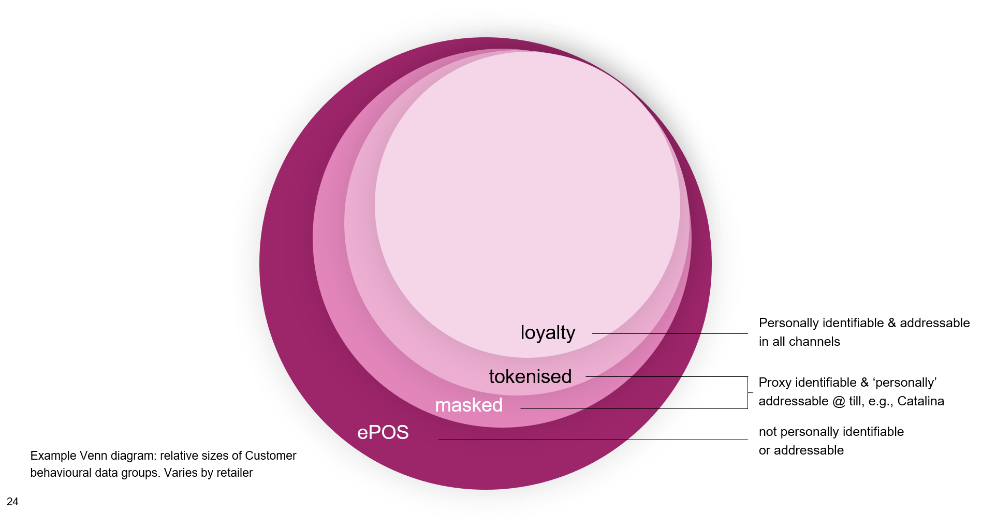You have more ‘loyalty’ data than you think: leveraging Customer Data without a loyalty card
A dunnhumby perspective by Julie Sharrocks and David Ciancio
Nearly a half century ago now, during the summer of 1974, the first grocery store scanner was installed in a Marsh supermarket in Troy, Ohio. The very first barcode-scanned item was a pack of Juicy Fruit gum. Little did grocers then imagine the many transformative consequences that would arise from that scanner and a bit of chewing gum.
The science that enabled the scanner – from the laser to the UPC label (Universal Product Code) to the computer device that held the product details and prices and recorded the transactional details – were miracles of invention. But it’s the science that developed in analysing the scanner’s transactional details that is arguably more transformational to the retail and manufacturing and research industries, as this science drives the modern supply chain from end-to-end, Category Management and supplier collaboration, store labour productivity, and all applications of Customer Data Science including CRM, insights and personalisation.
Simply, scanners revolutionised data itself, creating vast Electronic Point of Sale (ePOS) logs of every item, every coupon, every discount, every payment, in every transaction in every store, every day for the past 47 years.
Not widely understood is the truth that this ePOS data accurately describes Customer behaviour if you know how to look for it – and ePOS data can be mined to improve the Customer experience and grow loyalty, and operationalised and monetised, in ways similar to loyalty data.
Again today, there’s a new transformational science for non-personalised data that is enabling rich shopper insights for channels and value propositions without a loyalty card, and in those formats and departments where loyalty card penetration is low (for those with cards). In fact, this powerful new ePOS science delivers many more of the benefits of Customer data science than retailers might think are available, including deep insights to improve decisions in assortment, pricing, and promotion.

Customer Data comes in four levels of personal identifiability

The key difference between ePOS data and ‘loyalty’ data is about individual Customer identifiability and addressability – and these differences might be overrated, depending on your Customer value proposition and your market or channel!
ePos data:
- Individual basket transactions that include no personal Customer identifiers, also called ‘scan’, ‘ticket’, ‘basket’, ‘transaction’, or ‘pure ePOS’
- ‘Customer’ behaviour is implied, based on the basket-level data
Masked data:
- A ‘pseudo-Customer proxy’ or ‘pseudonymised ID’ is created using a part of a payment card number – but not the full card number – and is then matched to a store number to identify an individual basket.
- The same Customer Proxy scheme is repeatable, allowing tracking of basket ID 1234129 over time (provided the same card is used in the same store).
- Compared to ‘basket’ ePOS, this level allows for longitudinal analysis
- Complications: depending on the partial card number used, there can be duplicate proxy IDs
- Example: the first four card digits for a Mastercard are the same for each issuing bank, so there might be many Customers using a card that starts with 5517 in store 129, thereby creating many 5517129 proxy IDs
- Accordingly, measurements like ‘visits per Customer’ are spurious when using masked data alone
Tokenised data:
- The process of substituting a sensitive data element (e.g. any personally identifiable information like a credit or debit card) with a non-sensitive surrogate or ‘token’ equivalent, that has no extrinsic or exploitable meaning or value. The token is a reference (i.e. identifier) that maps back to the sensitive data through a tokenisation system.
- A token puts the original, sensitive data outside of its original environment ‘encryption’ or ‘hashing’ which encodes / decodes the sensitive data within its original environment. Further, the token renders the data compliant to the Payment Card Industry Data Security Standard (PCI DSS), which ensures both security and Customer privacy
- This token effectively becomes a proxy for a loyalty card, allowing for linking individual transactions over time, without the duplicate proxy complications listed for masked data
Loyalty data:
- The most sensitive level of Customer data in terms of privacy, because a unique identifier has been assigned to an individual person, typically through a barcode or magnetic stripe on a loyalty card, or via a phone number, national ID number, IP address, sticker, or the like
- This identifier is scanned at the point of sale (POS) or recognised as a unique IP address in the case of online transactions. Details of what the Customer bought associated with that identifier are stored into a database.
Foundational Customer Data Science
The arrival of loyalty data (in the mid-1990s) enabled dunnhumby – the first of the Customer data scientists – to follow shoppers through their purchasing over time. This so-called longitudinal analysis meant we could see which products were bought again and again by the same Customer, and what choices Customers made to substitute a product in the event of out of stock, change in assortment, or change in price or promotion, for examples. Understanding product substitutability became the bedrock of all Customer-led category science, unlocking the ability to evaluate, optimise, and predict retail decisions around assortment or price & promotion.
Exploiting every ounce of data
Of course, not all retailers desire to offer loyalty programmes or cards, depending on their strategy or Customer value propositions, and particularly in discount and convenience channels.
Moreover, even at best, the typical retailer sees 70% of sales going through on loyalty cards (and often considerably less for convenience formats or certain Customer segments). Squeezing every bit of available data for use is critically important, and so gone are the days when the remaining 30% of ‘ePOS’ data would be simply thrown away.
A blended approach wherein the best of ePOS science and the best of Customer science together is superior, and increasingly necessary for making difficult retail decisions in an ever-disrupted retail environment.
Accordingly, data science has had to evolve to derive product substitutes without the personally identifiable and longitudinal data that was originally fundamental to the science itself. Fortunately, science and machine learning has evolved considerably as well. For example, dunnhumby seized on the hot new science called ‘vector embeddings’, already used widely in natural language processing, via our Academic Partnership programme.
Cool and powerful new ePOS data science
Vector embedding techniques are used widely for search terms and document retrieval. The ‘vectors’ are like fingerprints in that each word has a unique numerical string (vector) depending on the context it is found it relative to other words in the same document or webpage. The idea is that words with closely matched fingerprints (similar vectors) have similar meanings.
Now here’s the cool bit – we take the concept and apply it to the world of grocery shopping, but instead of a word in the context of a document, we have a product in the context of a basket. In looking across the contents of all the baskets where we find a given product, we create a fingerprint for that product. For example – we find that a certain type of coffee is often bought with orange juice and croissant. In the simplest sense, orange juice and croissant, and the absence of other products, would become the fingerprint for this product. And if we look for products with a similar fingerprint, we are likely led to other coffee products.
Imagine greatly fine tuning this science on thousands of products in millions of baskets; not only can this science become extremely powerful, but arguably even more powerful than loyalty card-derived methods alone.
Our legacy in Customer data has made us experts in non-personalised data
This type of unsupervised machine learning is not straightforward to implement. In category science, for example, there is no absolute truth to point the machine to, no true north, no objective function against which to model or measure the new results. For example, some put Pepsi Max as the best substitute for product Coke Zero, whilst others argue for Diet Pepsi; either can be correct.
dunnhumby have two great advantages in 25+ years of experience with hundreds of category management experts in the top retailers all over the world, and in a well-proven substitution science based on personalised Customer (loyalty) data. This meant that we could compare ePOS substitutability versus our best-in-class Customer substitutability and challenge the results for both. The comparisons concluded that ePOS substitutability science well complements and supplements existing Customer science.
Cool Convenience channel applications of ePOS data science
Convenience store operators face unique challenges over their supermarket chain counterparts, like different ranges and sets by store or franchise, and this creates data complexities and a kind of ‘chaos’ across the network. The new ePOS data science turns this chaos to an asset rather than a barrier, by using machine learning techniques like recommender algorithms to learn relationships in volatile environments.
Collaborative filtering is a type of recommender algorithm used by many websites to suggest products to their Customers, e.g., “shoppers with similar interests to you also liked product X.” In effect, these algorithms learn from chaotic product interrelationships to understand “people like me”. In the new ePOS science, similar recommendation algorithms learn from other convenience stores how well a product performs in the context of a certain category range, and the resulting science delivers a “store like me” recommendation that outperforms the typical approach (which only looks at top selling items, for example).
Don’t underestimate the value of non-loyalty ePOS data: Key takeaways
- ePOS data accurately describes Customer behaviour if you know how to look for it – so you have more ‘loyalty’ data than you think
- ePOS data can be mined to improve the Customer experience and grow loyalty, even if you don’t offer a loyalty card programme
- ePOS data can be and operationalised and monetised in ways similar to loyalty data
- If you do have data from a loyalty card, ePOS data science can fill in the gaps
- ePOS science has become arguably even more powerful than loyalty card-derived methods, depending on format, channel, or value proposition.
- ePOS data science is a build on loyalty data, not a regression from it
dunnhumby have over 25 years of expertise in transformational ePOS customer data science, working with Discount, Convenience, and customary supermarket operators without a traditional loyalty programme. Get in touch with your local dunnhumby team to discover how you could maximise your ePOS data to better understand your Customers.
RELATED PRODUCTS
Truly understand your Customers and unlock your Customer First transformation with Strategy Development, Research & Insights and Organisation Engagement
Build a differentiated Customer strategyThe latest insights from our experts around the world
Understanding evolving customer needs in the age of AI and data abundance


